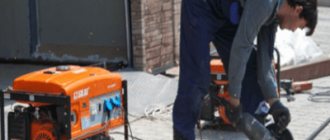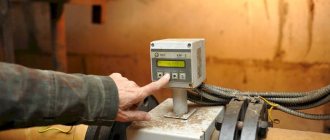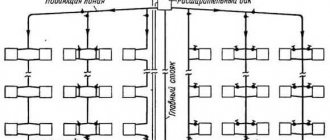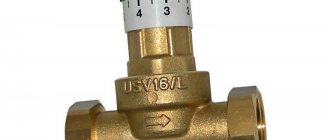Individual heating in residential buildings
In addition to central heating, you can find autonomous heating of an apartment in an apartment building; usually such a heat supply is rare and has been installed in new buildings in recent years. Local heat supply systems are also used in the private residential sector. For individual heating in an apartment building, the boiler room is usually located either in the building itself in a separate room or close to the house, since it is necessary to regulate the temperature of the coolant in the heating system.
The cost of autonomous heating in an apartment building is quite high, so it is preferable to commission one powerful boiler house that can provide heat and hot water to a residential neighborhood.
Central heating of apartment buildings
Through main pipelines, coolant from the central boiler room is supplied to the heating unit of an apartment building and is further distributed among the apartments.
In this case, additional adjustment of the degree of hot water supply is carried out directly at the heating point, for which circular pumps are used. This method of supplying coolant to the end consumer is called independent (more details: “Central heating is both pros and cons”). In addition, dependent heating systems are used in apartment buildings. In this case, the coolant is transported to apartment radiators without additional distribution directly from the thermal power plant. In this case, the water temperature is determined regardless of whether it is supplied through a distribution point or directly to consumers.
Types of heating systems in an apartment building can be open or closed (for more details: “Open and closed heating systems - advantages and disadvantages in comparison”).
In the latter option, the coolant from the thermal power plant or central boiler room, after entering the distribution point, is supplied separately to heating radiators and to the hot water supply. In open systems, such a separation is not provided for by the design and heated water for the needs of residents is supplied from the main pipe, so consumers are left without hot water supply outside the heating season, which causes many complaints about utility services.
Heating a private house with electricity
It can be either primary or additional. Heating occurs due to the conversion of electrical energy into a thermal component using tubular or spiral-type electric heaters.
Heating with electricity advantages:
— the ability to transport heaters from one room to another;
Heating with electricity disadvantages:
- high costs for heating premises due to the high cost of electricity;
— the need for a fresh portion of clean air due to the combustion of oxygen inside the building by devices of this type (the premises must be frequently ventilated);
— inability to complete assigned tasks in the absence of power supply or frequent interruptions.
Heating a country house using heating devices powered by electrical energy can be justified in very small buildings that have good insulation of the floor, facade and ceiling, or as additional heating in large houses.
Single pipe heating system
Single-pipe heat supply to an apartment building has a lot of disadvantages, the main one being significant heat losses during the transportation of hot water.
In this circuit, the coolant is supplied from the bottom up, after which it enters the batteries, gives off heat and returns back to the same pipe. Hot water first reaches the end consumers living on the upper floors in a barely warm state. There are cases when a single-pipe system is further simplified, trying to increase the temperature of the coolant in the radiators. To do this, the battery is cut directly into the pipe. As a result, it seems that the radiator is its continuation. But only the first users of the system receive more heat from such a connection, and the water reaches the last consumers almost cold (about
Types of connections
It is not within your power to change the layout of the centralized water circuit, so adjusting the heating system of an apartment building can only be done at the level of your apartment. Undoubtedly, there are situations when, in a single building, residents completely redo the system, but here the so-called “localization” comes into force, and the principles of heating using one or two pipes remain unchanged.
On this page you can also watch a video clip that will help you understand the topic.
Single pipe heating system
- Due to their economy, single-pipe heating systems for apartment buildings have many disadvantages, and the main one is the large heat loss along the route . That is, water in such a circuit is supplied from the bottom up, getting into the radiators in each apartment and giving off heat, because the water cooled in the device returns to the same pipe. The coolant reaches its final destination having already cooled down considerably, so complaints are often heard from residents of the upper floors.
- But sometimes such a system is simplified even more, trying to raise the temperature in the heating radiators, and to do this they are cut directly into the pipe. It turns out that the radiator itself is a continuation of the pipe, as shown in the lower diagram.
- Only the first users benefit from such a connection, and the last apartments get even colder water. In addition, the ability to adjust the radiators is lost, because by reducing the flow in a single battery, you reduce the water flow throughout the entire pipe. It also turns out that during the heating season you will not be able to change the radiator without draining the water from the entire system, so in such cases jumpers are installed that allow you to turn off the device and direct water through them.
- For single-pipe heating systems, the ideal solution would be to arrange the radiators according to size, that is, the first batteries should be the smallest and, gradually increasing, the largest devices should be connected at the end. Such a distribution could solve the problem of uniform heating, but, as you yourself understand, no one will do this. It turns out that saving money on installing a heating circuit results in problems with heat distribution and, as a result, residents’ complaints about the cold in their apartments.
Two-pipe heating system
- A two-pipe heating system in an apartment building can be open or closed, but it allows you to keep the coolant at a certain temperature for radiators of any level . Take a look at the radiator wiring diagram below and you'll see why this is so.
- In a two-pipe heating circuit, the cooled water from the radiator no longer returns to the same pipe, but is discharged into the return channel or “return”. Moreover, it does not matter at all whether the radiator is connected from a riser or from a sun lounger - the main thing is that the temperature of the coolant remains unchanged along the entire path along the supply pipe.
- An important advantage in a two-pipe circuit is the fact that you can regulate each battery separately and even install taps with a thermostat on it to automatically maintain the temperature. Also in such a circuit you can use devices with side and bottom connections, use dead-end and parallel movement of the coolant.
Hot water supply in heating systems
DHW in multi-storey buildings is usually centralized, with water heated in boiler rooms.
Hot water supply is connected from heating circuits, both single-pipe and double-pipe. The temperature in the hot water tap in the morning can be warm or cold, depending on the number of main pipes. If there is a single-pipe heating supply to an apartment building with a height of 5 floors, then when you open a hot tap, cold water will flow out of it first within half a minute. The reason lies in the fact that at night, rarely do any residents turn on the hot water tap, and the coolant in the pipes cools down. As a result, there is an overconsumption of unnecessary cooled water, since it is drained directly into the sewer.
Unlike a single-pipe system, in a two-pipe version, hot water circulates continuously, so the above-described problem with hot water does not arise there. True, in some houses, a riser with pipes is looped through the hot water supply system - heated towel rails, which are hot even in the summer heat.
Many consumers are interested in the problem with hot water supply after the heating season has ended. Sometimes hot water disappears for a long time. The fact is that utility services are obliged to comply with the rules for heating apartment buildings, according to which it is necessary to carry out post-heating tests of heat supply systems (pro
Connecting radiators to the system
After the pipe routing method has been chosen, heating batteries are connected to the circuit; the circuit also regulates the connection order and the type of radiators used. At this stage, the heating scheme for a three-story building will not differ radically from the heating scheme for a high-rise building.
Since the central heating system is characterized by stable operation, versatility and has an acceptable ratio of temperature and pressure of the coolant, the connection diagram for heating radiators in an apartment may involve the use of batteries made of various metals. In multi-storey buildings, cast iron, bimetallic, aluminum and steel radiators can be used, which will complement the central heating system and provide apartment owners with the opportunity to live in comfortable temperature conditions.
Radiators for heating systems of high-rise buildings
Cast iron radiators, which have previously been used for decades, are familiar to many residents of multi-storey buildings.
If it is necessary to replace such a heating battery, it is dismantled and a similar one is installed, which is required by the heating system in an apartment building. Such radiators for centralized heating systems are considered the best solution, since they can withstand fairly high pressure without problems. The passport for a cast iron battery indicates two numbers: the first of them indicates the operating pressure, and the second indicates the test (pressure) load. Typically these values are 6/15 or 8/15. The higher the residential building, the greater the operating pressure. In nine-story buildings it reaches 6 atmospheres, so cast iron radiators are suitable for them. But when it is a 22-story building, then for the working functioning of centralized heating systems, 15 atmospheres will be required. In this case, steel or bimetallic heating devices are needed.
Experts do not recommend using aluminum radiators for central heating - they are not able to withstand the operating condition of the water circuit. Also, professionals advise property owners, when carrying out major renovations in apartments and replacing batteries, to change the coolant distribution pipes to ½ or ¾ inches. Usually they are in poor condition and it is advisable to install ecoplast products instead.
Some types of radiators (steel and bimetallic) have narrower water flows than cast iron products, so they become clogged and subsequently lose power. Therefore, at the point where the coolant is supplied to the battery, a filter should be installed, which is usually mounted in front of the water meter.
Pipelines: reasons for low heating
Determining air pockets in batteries using a thermal imager
Failures in the heating mode are typical for a two-pipe heating system. In this case, the supply line that distributes the coolant to the radiators does not heat. Identification of the “problem” area can be done by measuring the temperature on the surface of the pipes or a thermal imager.
Natural circulation
Pipe slope for heating with natural circulation
What can cause such problems? If the heating does not heat well, the slope of the line may not be observed. This only applies to natural circulation systems. According to the standards, the slope of the pipes should be 10 mm per 1 m.p. In addition, the direction is taken into account - from the accelerating riser to the radiators. For the return pipe, the slope must be towards the boiler.
At the first stage, it is necessary to measure this indicator using a building level. If it meets the standard, but the heating radiator does not heat, there is a possibility of air pockets forming. In this case, an integrated approach is recommended, which includes the following steps:
- Measuring the angle of inclination. If necessary, change it to the required value;
- Flushing pipes to remove limescale;
- Filling the system with coolant with open Mayevsky taps on the radiators.
This technique will eliminate the low heat transfer rate of the heating system.
Forced coolant circulation
Operating principle of an air vent
For a system with forced movement of water in pipes, the formation of air locks can be avoided by using an air vent installed at the top of the system. In part, it performs the functions of an open expansion tank, but it does not reduce the pressure in the pipes to a critical level. Its absence is an indirect cause of poor heating of the radiator.
The specificity of closed heating systems is that it is not necessary to comply with the installation level of the pipes. However, when the critical heating level of the coolant is exceeded, steam is released, which is the main cause of air locks. Since air has a lower density than water, it will concentrate in the upper region of the pipeline sections. If heating radiators in a closed system do not heat well, the reason may be a decrease in the volume of coolant in the pipes due to air resistance.
What needs to be done in this case? First of all, check the functionality of the air vents. If the valve is idle for a long time, it may become covered with limescale, which makes it impossible to open it under air pressure.
In addition to this factor, it is necessary to take into account the excess of hydraulic resistance in the system. This is why the heating battery does not heat if the initial calculation is incorrect. Therefore, before you begin installing a new system or upgrading an old one, you should perform the calculation of the operational and technical parameters:
- Selection of pipes of the appropriate diameter - the larger it is, the lower the hydrodynamic resistance. However, this increases the volume of water;
- The likelihood that a two-pipe heating system will not heat is significantly less than that of a single-pipe one. Therefore, it is preferable to install radiators with parallel connections;
- Heating of the heating circulation pump occurs due to incorrectly selected power. It directly depends on the calculated hydrodynamic parameters.
The video shows the main reasons for poor radiator heating for a single-pipe heating system:










